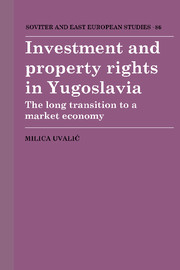Book contents
- Frontmatter
- Contents
- List of figures
- List of tables
- Preface and acknowledgements
- Introduction
- Part I The institutional and theoretical framework
- Part II Empirical evidence on the nature of the Yugoslav system
- 5 Yugoslav investment and savings performance
- 6 The determinants of investment in Yugoslavia
- 7 Econometric tests of Yugoslav investment behaviour
- Part III Pressure for more radical reforms in Yugoslavia
- Notes
- List of references
- Index
- Series list
7 - Econometric tests of Yugoslav investment behaviour
Published online by Cambridge University Press: 11 January 2010
- Frontmatter
- Contents
- List of figures
- List of tables
- Preface and acknowledgements
- Introduction
- Part I The institutional and theoretical framework
- Part II Empirical evidence on the nature of the Yugoslav system
- 5 Yugoslav investment and savings performance
- 6 The determinants of investment in Yugoslavia
- 7 Econometric tests of Yugoslav investment behaviour
- Part III Pressure for more radical reforms in Yugoslavia
- Notes
- List of references
- Index
- Series list
Summary
Furubotn and Pejovich's theory will now be compared with Kornai's theory in order to assess, using econometric methods, which of the two theories offers a better analysis of investment in Yugoslavia. The two theories are first considered separately, evaluating the role of the alternative groups of variables proposed by each of the two theories as being crucial for explaining savings deposits, investment and selffinanced investment. The theories are then evaluated jointly, applying the complete parameter-encompassing procedure (unrestrictedrestricted model).
Testing Furubotn and Pejovich's theory
The most explicit statement made by Furubotn and Pejovich on the determinants of savings, investment and self-financed investment in a Yugoslav-type LMF is found in their 1973 (p. 281) article: ‘We find that (1) the shorter the collective's planning horizon, (2) the higher the rate s [interest paid on savings deposits], (3) the lower the rate i [cost of bank credit], and (4) the lower the marginal productivity of capital in the firm, the less attractive are non-owned assets in comparison with owned assets and the less likely is self-finance activity.’ The theory therefore maintains that savings deposits, investment, and selffinanced investment are determined by the planning horizon, the interest rate on savings deposits, the cost of bank credit, and capital returns, the first three variables being the dependent, and the last four being the explanatory variables.
- Type
- Chapter
- Information
- Investment and Property Rights in YugoslaviaThe Long Transition to a Market Economy, pp. 124 - 154Publisher: Cambridge University PressPrint publication year: 1992



